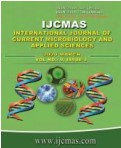


 National Academy of Agricultural Sciences (NAAS)
National Academy of Agricultural Sciences (NAAS)

|
PRINT ISSN : 2319-7692
Online ISSN : 2319-7706 Issues : 12 per year Publisher : Excellent Publishers Email : editorijcmas@gmail.com / submit@ijcmas.com Editor-in-chief: Dr.M.Prakash Index Copernicus ICV 2018: 95.39 NAAS RATING 2020: 5.38 |
A one year old intact male Dobermann dog was brought to Small Animal Surgery Out Patient ward unit at Madras Veterinary College Teaching Hospital with the history of acute vomition and diarrhoea for the past four days. The animal was anorectic and severely dehydrated with a congested mucous membrane. A hard-painful irregular contoured moveable mass was observed on abdominal palpation. Lateral and ventrodorsal abdominal and thoracic radiographs were taken to rule out foreign body, which revealed a radiopaque irregularly shaped foreign body at the caudal intestine. An ultrasound examination disclosed the presence of a foreign body. A routine haematobiochemical profile was taken to ascertain organ health status. Marginal anaemia accompanied by increased ALP and BUN values were present. The animal was stabilised with fluid therapy in order to counteract dehydration and electrolyte imbalance. Midventral celiotomy was planned and performed following stabilisation. An enterotomy was done to remove the foreign body. Since the intestines cranial and caudal to the obstruction were devitalised, with the absence of peristalsis and mesenteric pulse, enterectomy followed by enteroanastomosis was performed. Standardised post-operative care and treatment were administered until the dog had an uneventful recovery.
 |
 |
 |
 |
 |